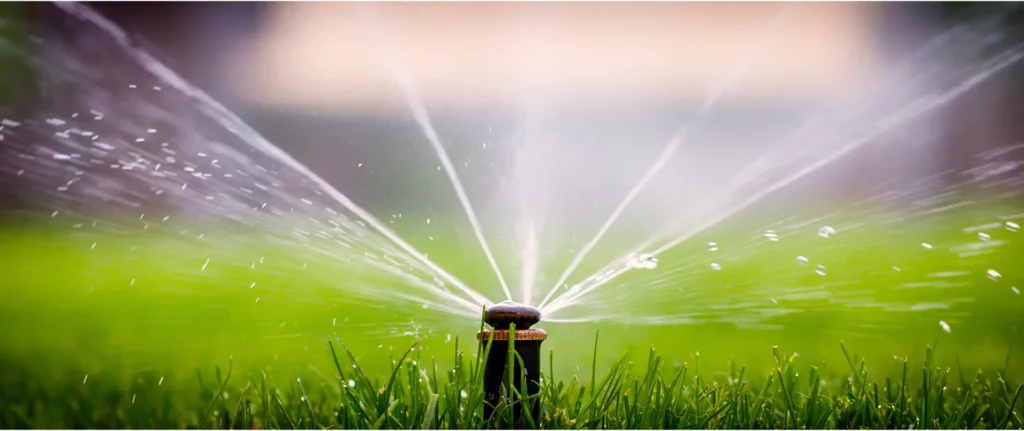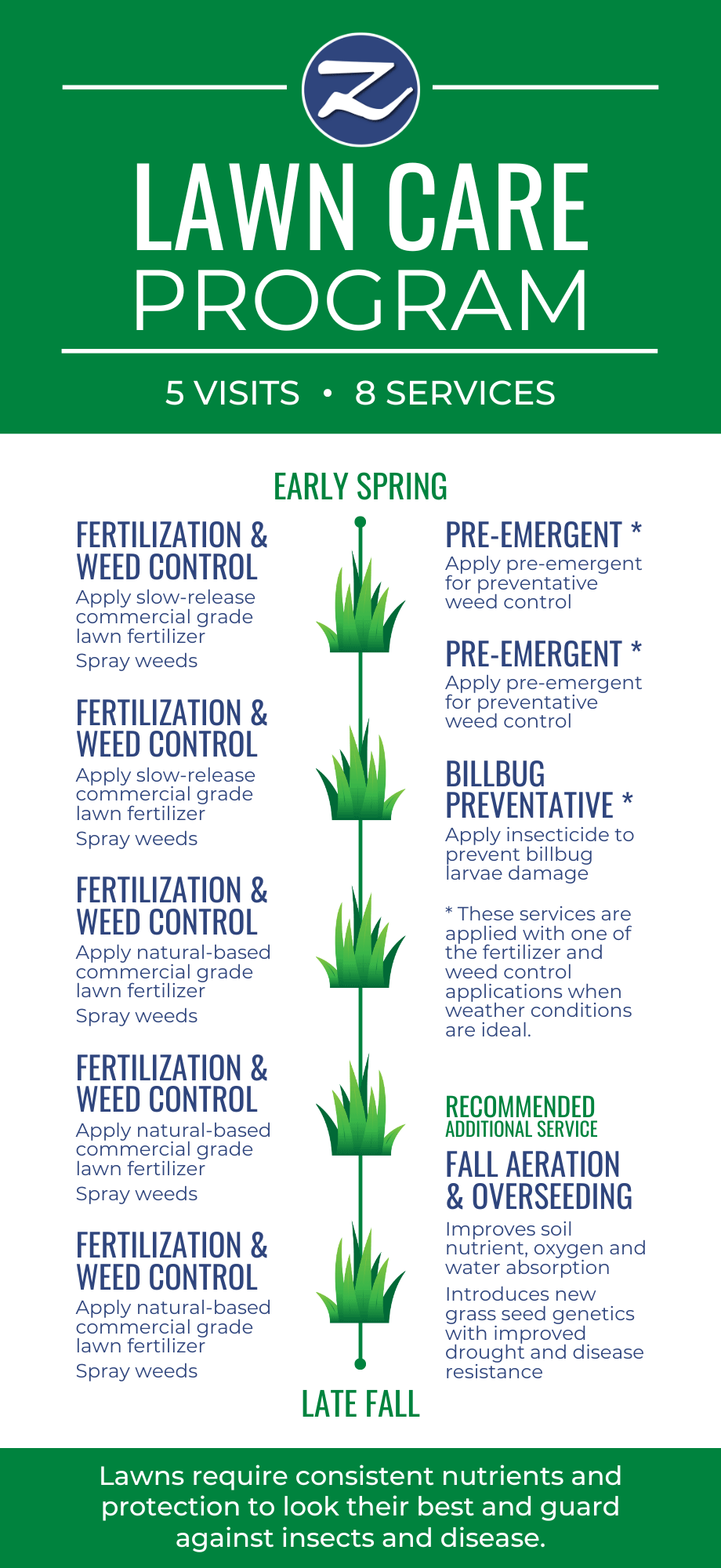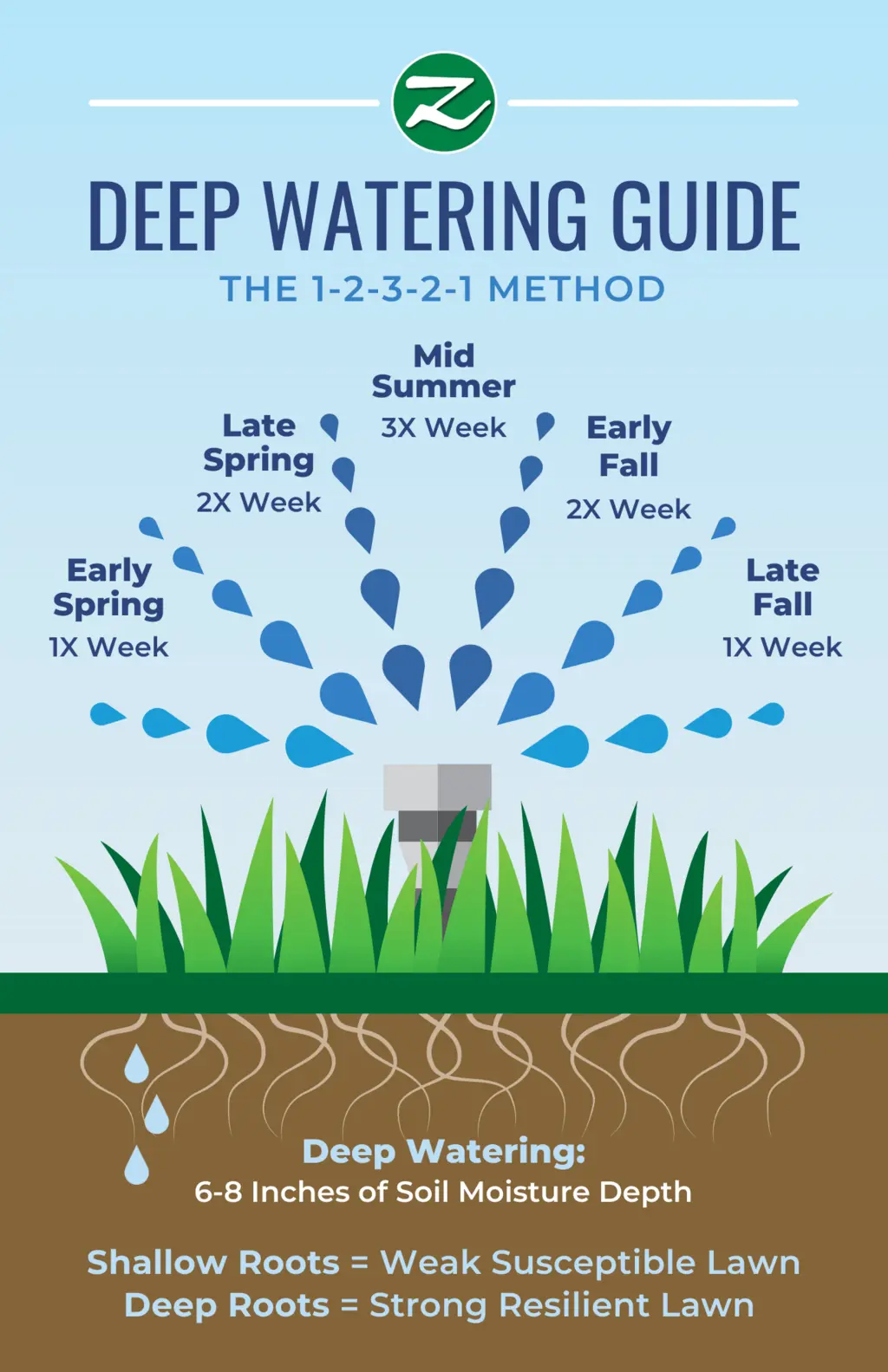Home » Property Care Tips » Lawn

If water does not penetrate deeper than a few inches into the soil, your lawn’s root system will be shallow. Letting your lawn dry out in between watering encourages your lawn to send its roots deeper in search of moisture.
It is important to adjust your lawn watering schedule based on the season because the amount of water needed by the grass can vary depending on the weather conditions. During the cooler spring and fall seasons, the grass requires less water as the temperatures are mild and the air is often moist. Watering your lawn less frequently during these seasons can help prevent over-saturation, which can lead to disease and fungal growth. In contrast, during the hot and dry summer season, lawns need more water to stay healthy and avoid drying out. Watering deeply a few times a week instead of every day can help the grass develop deep roots, making it more resistant to drought conditions.
Over-watering and shallow watering can cause shallow root systems in lawns which can increase their susceptibility to drought and other stresses. Additionally, this can foster the growth of pests and weeds that thrive in damp environments.
Deep watering helps the water to seep into the soil, prompting roots to extend deeper in search of water. This can aid in making the grass more tolerant to drought and lowering overall water usage. Adapting your lawn watering routine according to the season and watering deeply a few times a week can help maintain a healthy and lively lawn all year round.
You can read our blog article on optimal watering and mowing practices and why deep lawn roots matter.
Here is a helpful informational pdf from Colorado State University on the best techniques for watering established lawns.



We want our customers to be absolutely delighted by our services! If you have signed up for any of our full season programs and if for any reason you are not absolutely happy with our work, we won’t be happy either.
That means we will immediately send our team to fix the problem, no questions asked. We want you to be completely satisfied with our services. Let us prove it to you!
Quick and simple audit system to ensure your lawn is receiving the correct amount of water it needs.
Evenly space all four irrigation gauge cups in the first zone of your irrigation system. Run the irrigation system for 15 minutes, then turn it off.
Keep track of the water amounts in each cup. If there are unequal amounts, this indicates uneven coverage, and adjustments are necessary.
Pour the water from all four cups into one cup. This will give you the approximate water output per hour in that zone. (4 x 15min = 60min)
Repeat in all zones to identify water output and any coverage issues. Your lawn will need a minimum of 1-2″ of water each week depending on the weather. Zones in shady areas will not need as much water as zones in sunny areas. The best indicator is achieving a consistent soil moisture depth of 6-8″.
Tips: As temperatures rise, increase watering run times to maintain a consistent soil moisture depth of 6-8″. Test soil moisture depth by probing the lawn with a long screwdriver. Deep, infrequent watering is better than light, frequent watering. A general rule of thumb for correct watering practices is to use the 1-2-3-2-1 method.
If your property has compacted or clay soil or a sloped yard, it is recommended to use the cycle and soak watering method. This method can improve how well the soil absorbs water and prevent water and soil runoff.
First, determine how much water your lawn needs based on the type of grass and soil you have. Then, divide the total watering time into smaller cycles.
If you need to water for 30 minutes, you can do three cycles of 10 minutes each, with breaks of around 30 minutes in between.
This allows the soil to absorb the water slowly, encouraging the lawn to grow deep roots. As a result, you won’t need to water your lawn as often.
Before starting the next cycle, check the soil’s moisture and consider the current weather conditions. Based on what you observe, make any necessary adjustments. By following these steps, you can ensure that your lawn receives the correct amount of water, grows deeper roots, and conserves water.
To learn more about the cycle and soak watering method, read the EPA (United States Environmental Protection Agency) brochure.
Mowing your lawn at the right time of day and correct height is crucial for maintaining its health and appearance, as it can prevent stress caused by extreme temperatures and help the grass retain moisture and develop strong roots, making it more resistant to drought conditions. Mowing too short or tall can damage the grass and make it more susceptible to pests, diseases, and fungal growth.
In Idaho, the weather can vary greatly depending on the season. During the summer months, it’s important to keep your lawn around 2.5 to 3 inches high to help it withstand the hot and dry conditions. In the fall and spring, when the weather is cooler, you can raise the mower height to around 3.5 inches to help the grass retain moisture.
To maintain a healthy lawn, it’s important to mow it regularly. During the growing season in Idaho, which typically spans from spring to summer, it’s recommended to mow once a week. As for the fall season, you may be able to reduce the frequency of mowing to every other week, depending on the weather conditions. It’s also important to mow at the right time of day, choosing the early morning or late afternoon when the sun is less intense. This will help prevent the grass from becoming stressed and losing moisture, which can lead to browning and disease.
Maintaining a neat and tidy lawn is not just for aesthetic purposes, but also for practical reasons. Clearing debris, leaves, and other materials off your lawn can have a significant impact on the health and growth of your lawn, as well as on the safety of your property.
The Treasure Valley experiences hot summers and cold winters, which can be tough on lawns. Leaves, twigs, and other debris can prevent sunlight and water from reaching the grass, leading to patchy or dead spots. Clearing debris, hoses, and other materials off your lawn can help ensure proper water and sunlight reach your grass, promoting healthy growth. Leaves left on the lawn during fall and winter can create a breeding ground for diseases and insects, damaging your lawn and potentially spreading to other areas of your property.
Keeping your lawn covered in debris and leaves can be a safety hazard, particularly for children or pets who play in the yard. Fallen branches and debris can cause tripping hazards, while leaves can become slippery and cause falls. Additionally, leaving dead leaves on your lawn can increase the risk of fire during dry summer droughts. Regularly clearing debris from your lawn helps prevent safety hazards and ensures your property remains safe for outdoor activities.
Maintaining a well-kept lawn that is free of leaves and debris can save a significant amount of time and money. Not only does it promote healthy lawn growth, but it also simplifies mowing and maintenance, reducing the time and effort required. Furthermore, a lawn that is well-maintained and clear of debris makes it easier for early detection of issues, which can prevent costly repairs or replacements in the future.
Mowing your lawn at the right time of day and correct height is crucial for maintaining its health and appearance, as it can prevent stress caused by extreme temperatures and help the grass retain moisture and develop strong roots, making it more resistant to drought conditions. Mowing too short or tall can damage the grass and make it more susceptible to pests, diseases, and fungal growth.
Check out our blog to learn about Preventative Grub Control.
Keeping an eye out for lawn stress is essential for maintaining a healthy lawn in Idaho. Wilting or browning grass, a thinning lawn, or a dull green color are common indicators of lawn stress. If footprints remain on the lawn or the grass feels spongy when walked on, it may also be a sign of lawn stress. Being aware of these signs can help you prevent serious damage to your lawn.
Lawn diseases can be caused by a variety of factors, including fungi, bacteria, and viruses. To identify signs of lawn disease, look for irregular patches of dead or discolored grass, thinning grass, or the presence of mushrooms or other fungi on the lawn. Other signs of lawn disease may include a sticky or slimy substance on the grass blades or a foul smell.
Insects can wreak havoc on your lawn, so it’s important to know how to spot them. Look for holes or damage to the grass blades, yellowing or browning grass, or seeing insects in the lawn, such as grubs, sod webworms, or billbugs. Billbugs can cause the same signs as drought. Keep an eye out for wilting or thinning grass, or the presence of tunnels or mounds of dirt, as these may also indicate lawn insect problems.
For more information on lawn issues and how to prevent them, visit Lawn Issues in the Treasure Valley.
Learn about 5 of the Most Common Weeds Found in Boise, Idaho.
Read about How to Grow a Lawn in Idaho That Resists Drought, Weeds, & Insect Invasion.
Get tips on how to Help Your Lawn & Landscape Survive a Drought-Stricken Summer in Idaho.
Duo voluptua justo ipsum sadipscing sit diam. Gubergren sit ipsum tempor dolores, magna dolor sanctus est amet et tempor. Sit sanctus duo lorem invidunt amet amet. Ipsum sanctus sadipscing accusam voluptua lorem sanctus et. Clita erat sanctus diam eirmod justo gubergren lorem, clita diam.
Lawn aeration is a simple and effective process that helps to reduce thatch buildup by making small holes in the soil to allow air, water, and nutrients to penetrate more deeply, promoting root growth and overall lawn health. This process should be done once or twice a year, depending on your lawn’s specific needs and soil conditions.
Maintaining your lawn properly is key to preventing thatch buildup. This includes mowing at the correct height, watering deeply and infrequently, and using the appropriate amount of fertilizer. It’s also important to remove dead leaves off your lawn and rake up excess grass clippings after mowing.
If you already have a significant thatch buildup, dethatching may be needed to remove the layer of dead grass and other organic materials that have accumulated on the soil’s surface. Dethatching can be done manually with a thatch rake or mechanically with a power dethatcher. However, excessive dethatching can harm the grass, so it should be done only when necessary.
You can read more about thatch buildup and why aeration is the preferred method of managing thick thatch over power raking in our blog article: Power Raking vs Aerating: How to Manage Lawn Thatch.
To learn more about power raking and lawn aerating watch this video by Pest & Lawn Ginga, Differences Between Power Raking and Lawn Aeration.
For more information about lawn thatch and lawn aerations, read the University of Idaho Extension Publication Core Aeration of Lawns – Benefits and Procedures.
Read our blog article to learn how lawn aeration and overseeding can improve the health of your lawn: Lawn Aerations and Overseeding – Key Maintenance Tasks
Idaho’s unique climate and weather patterns make it essential to use the right type of grass to ensure a healthy and lush lawn. Among the various grass types, cool-season grasses have proven to be the best-suited for our region. Their ability to thrive in colder temperatures and adapt to the extreme weather conditions of Idaho has made them the go-to choice for many homeowners.
At Zing, we understand the importance of using the correct types of grass seed for overseeding. Therefore, we use a premium blend of 60% ryegrass and 40% Kentucky bluegrass that thrive well in Idaho’s climate, providing a perfect combination of durability, rapid germination, and quick spreading.
Ryegrass is a popular cool-season grass that is well-suited to the Idaho climate. This grass type is a vibrant green with a fine blade that makes it visually appealing. Ryegrass is particularly well-suited to high-traffic areas of your lawn, such as play areas or paths. It also tends to germinate quickly, making it a popular choice for overseeding. Furthermore, ryegrass can help prevent soil erosion, making it a great choice for sloping or hilly lawns.
Kentucky bluegrass is another cool-season grass that is commonly used in Idaho lawns. It is deep green with a fine blade, making it an attractive choice for lawns. Kentucky bluegrass is also known for its durability and can withstand high foot traffic and play, making it an ideal choice for families with children and pets. Additionally, this grass type is known to spread rapidly, allowing it to quickly fill in bare or patchy areas of your lawn.
Caring for your lawn after overseeding helps ensure your new grass grows healthy and strong. Here are some care tips that will aid in achieving the best results from your overseeding and encourage the healthy growth of your new grass.
During the first week of overseeding, water your lawn lightly two to three times a day to keep the soil moist. An easy rule to follow is to keep the soil at an even chocolate-brown color. Once the new grass reaches 1 inch in height, follow the 1-2-3-2-1 watering method and water more deeply to encourage deep root growth.
Avoid walking on your lawn until it is established.
Don’t pull weeds or use herbicides until your new grass is well established, as they can damage or kill the new growth. It may be tempting to walk on it and remove the weeds, but keep in mind that once the new grass is grown, our lawn fertilizing and weed control program will quickly get the weeds under control.
About 4-6 weeks after overseeding, your lawn will benefit from a fertilizer application. To promote healthy growth, we use a natural-based fertilizer with a high nitrogen content that is locally manufactured in Idaho.
Wait 3-4 weeks for new grass to grow before mowing. Use a high mower blade setting of 3-4 inches to avoid damaging the delicate new growth. Gradually lower the blade height as the grass becomes more established.
Remember that overseeding is a process that takes time. Be patient and don’t expect to see results overnight. With proper care and maintenance, your lawn will begin to look lush and healthy in a few weeks.
Our team at Zing Services offers excellent lawn care services to commercial, residential, and HOA property owners. We serve the Treasure Valley, ID community, including Middleton, Star, Eagle, Meridian, and Nampa.
We have been cultivating healthy lawns in our area since 2010. Call us today at 208-585-9400 to schedule any of our lawn care services and to learn how to improve your lawn’s health.
Explore our website to learn more about the lawn care services we provide and how they can improve the health and beauty of your lawn.
